|
|
Club Officers and Volunteers
(Under Construction - Not everyone is shown.)
Steve Szabo, WB4OMM, #5913
Hi There! I'm Steve WB4OMM and hail from Port Orange, FL - just a few miles South of the World's Most Famous Beach - Daytona Beach! Born in Miami, raised in New York City, I've been here in FL since 1974. Got my original licence in Feb 1971 (WN2TAW).
I love every aspect of Ham Radio - but my favorite mode is QRP CW - especially portable operations ("Parkpeditions"). You can find out about me at QRZ.COM and there is a link to my personal ham web page there.
I operate most of the Sprints and other activities in NAQCC, as well as many other contests, activities and out-in-the-field ham radio.
If I have not worked you yet, I hope to do so soon!
72/73! Steve WB4OMM #5913
Immediate Past NAQCC President and Florida Chapter Lead
Paul Huff, N8XMS, #0675
NAQCC Past President 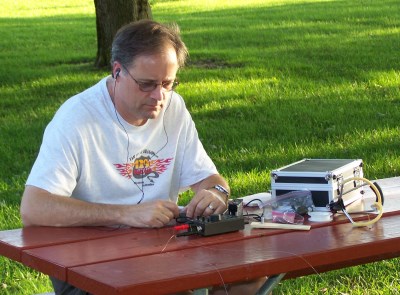 I was first licensed during my sophomore year in high school in 1970. We lived in Sioux Falls, SD and my call was WN0BJC. My grandfather, W0MA, lived in Leavenworth, KS and was my long-distance "Elmer." Locally, my junior high shop teacher, Bob Shuck, and the other members of the Sioux Falls ARC helped me to learn Morse code and study for my ticket.
I was first licensed during my sophomore year in high school in 1970. We lived in Sioux Falls, SD and my call was WN0BJC. My grandfather, W0MA, lived in Leavenworth, KS and was my long-distance "Elmer." Locally, my junior high shop teacher, Bob Shuck, and the other members of the Sioux Falls ARC helped me to learn Morse code and study for my ticket.My Novice station consisted of a huge old Hammarlund HQ-170 receiver that my grandfather gave me and an even older Heathkit AT-1 that Mr. Shuck loaned me. My antenna was a low, short, random-wire with a homebrew transmatch. I had two 40-meter crystals and of course a straight key. With this setup I was able to work throughout the Midwest, but almost never out of my own time zone, and I never worked any DX. I remember being amazed and a little jealous when a buddy of mine worked a California station for his first QSO with his new Heathkit HW-16. I was only on the air from Sioux Falls for a few months. My dad decided to go to graduate school so we moved to California, and a year later we moved to Michigan. Those moves took me off the air and my Novice license soon expired. College, career, and family all served to keep me away from the hobby for the next twenty-plus years. In 1993 I relearned the code, got my technician-plus ticket, and was given my current N8XMS callsign. Over the next few years I upgraded to General, Advanced, and Extra. In 2001 my wife and I went on a vacation to the Smoky Mountains and we stayed near TenTec headquarters in Sevierville, TN. We stopped in for a tour of the factory and I ended up purchasing a little T-Kit 1320 QRP transceiver kit. (I couldn't afford an Omni for my vacation souvenir!) I semi-successfully built the radio but had to send it back to the factory for alignment. Interestingly enough, my very first QRP QSO with that 1320 was with a ham in California! The 1320 started me down the path of my twin ham radio passions - kit building and QRP. Since then I have built several different QRP rigs. In 2003 I built an Elecraft K1 and shortly after that my QRO gear was mothballed and I became a QRPer exclusively. My current rig is an Elecraft K2 feeding my original 1993 Cushcraft R7 vertical. (The K2 does have the SSB option but that was mainly done just because I wanted to keep building stuff. I think that I've only had one SSB QSO and a few dozen PSK31 contacts.) I also have an Elecraft KX1 for portable operations. I use both a straight key and paddle on a regular basis and sometimes hook up a vintage bug as well. I am not much of a contester but I really do enjoy our NAQCC sprints. I also like working on our challenges each month. I work DX when I can, but would much rather have a nice CW chat than take 30-minutes to try to bust a pileup. I do most of my ragchewing on 40, 30, and 20 meters, and look for the DX on 17 through 10. I am a retired high school math teacher. In addition to ham radio I enjoy travelling, reading, pencil puzzles, and day-hiking. I also have modest collections of pocket knives and antique slide rules. My wife and I are active in church and Bible study activities. We have two grown children and one very special granddaughter. Don't ask me about her unless you have a lot of time to look at pictures and listen to me brag!
John Smithson, N8ZYA, #2278
NAQCC Vice-President / West Virginia Chapter  I've been licensed for 25 years now and my favorite mode of operation has been portable CW QRP radio. I don't like sitting in a windowless room on a beautiful day. I operate outdoors as much as possible.
I've been licensed for 25 years now and my favorite mode of operation has been portable CW QRP radio. I don't like sitting in a windowless room on a beautiful day. I operate outdoors as much as possible.I have both my QRP DXCC and QRP WAS awards and have worked numerous stations at more than a thousand miles per watt. I also hold the Friendship Award. You can literally work the world with 5 watts of power and a simple wire antenna. My favorite antenna is a dipole or a random wire. At home, I'm forced to use stealth antennas because of living in a historic district near the state capital building. I worked the lower 48 states, and many DX stations, with 40 and 20 meter Isotron antennas. They're controversial, but I like a challenge. I can stretch a 15 and 10 meter dipole inside the house but most of my DX contacts are done with a 50 ft length of radio shack speaker wire fed into a small MFJ tuner. It's a true "random wire" which zig zags over much of the upstairs living space and it's tied off to the downstairs stair railing. I like keeping things simple, and above all else, portable when the need arises. I'm also the manager of the West Virginia Chapter of the NAQCC club and always enjoy meeting new CW operators. I'll chase DX when the opportunity presents itself, but don't go out of my way, ever since earning the QRP DXCC award. I'm not a big contester. My favorite contact is a long CW QSO. I've done a lot of different stuff in my lifetime. I'm 66 years old and retired from a major paint company. I worked as a heavy equipment mechanic in the southern coal fields for about 10 years. My specialty was air conditioning. I held over 20 different jobs before I retired from the paint company. I'm a former Navy signalman and an official member of the Tonkin Gulf Yacht Club. I'm a graduate of West Virginia State University. I play the guitar, piano, ukulele, and recorder - none professionally - but enjoy playing for friends and small groups. I day hike, bike, and geocache. I have two children and five grandkids. I'm married to the best wife a man could ever hope for. We met while hiking with a local trail club. We have one small dog and four cats. The dog rules... John Griswold, KK1X, #2198
Awards Certificates, New Member Welcome Letters 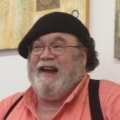 I've been a radio fan since the 60's, when my brother and I built a pair of Heathkit CB walkie-talkies (I think on Channel 9). Many years intervened (high school, Navy, 38 years of marriage, university, and career), until about Summer 2001, when my neighbor Philip N1PZ (SK) found out about my latent interest from a conversation with my wife.
I've been a radio fan since the 60's, when my brother and I built a pair of Heathkit CB walkie-talkies (I think on Channel 9). Many years intervened (high school, Navy, 38 years of marriage, university, and career), until about Summer 2001, when my neighbor Philip N1PZ (SK) found out about my latent interest from a conversation with my wife.Philip approached me and let me know that CW was no longer a requirement (sorry, wrong crowd for that, HI), and after taking a few exams on QRZ.com without even cracking a book, I took the train into MIT/Cambridge for one of their test sessions, and walked out with a Technicial license (well, at least the CSCE). At the time of passing my General I did have to pass the 5WPM code test, so I can at least claim credit for that, though my CW skills have never really bloomed, for lack of time to practice. I operate HF and VHF/UHF, contest in RTTY and phone, dabble in PSK and other digital modes, and every once in a while I'll punish some poor soul by completing a CW QSO. I have achieved Amateur Extra Class, not so much for the extra bandwidth, but so I could be a more useful Volunteer Examiner. I am Net Manager for Central Mass 2m Traffic Net, Secretary for Nashoba Valley ARC, Membership Manager for New England QRP, and Awards Manager for NAQCC. I thought about sorting QSL cards for the Buro, but I have enough going on. In addition to this, I'm a software engineer by trade, and an award-winning fiber artist, practicing spinning, weaving, knitting, and felting. The household consists of me, wife of 38 years Peggy, an aging mongrel dog and a pair of 2-year-old cats, sisters from the same litter. Hap OBrien, K7HAP, #4722
Challenge Results, Participation Records 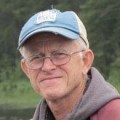 Although in high school I was interested in electronics and helped my dad in his radio-TV repair shop, a family friend who was an avid ham operator could not get me interested in ham radio. Later in 1968 I played with novice for awhile but never got real interested until 2008 when I was vacationing in AZ and met some hams at a local club. So during that vacation I qualified for tech/general and a couple years later the advanced. I gravitated to QRP CW SK and still can not get very motivated towards voice. My primary rig is a Flex-1500 with a Tentec 4020 as my portable rig and enjoy fiddling with portable antennas. I'm not big on contests but like to participate in the NAQCC and SKCC sprints when able.
Although in high school I was interested in electronics and helped my dad in his radio-TV repair shop, a family friend who was an avid ham operator could not get me interested in ham radio. Later in 1968 I played with novice for awhile but never got real interested until 2008 when I was vacationing in AZ and met some hams at a local club. So during that vacation I qualified for tech/general and a couple years later the advanced. I gravitated to QRP CW SK and still can not get very motivated towards voice. My primary rig is a Flex-1500 with a Tentec 4020 as my portable rig and enjoy fiddling with portable antennas. I'm not big on contests but like to participate in the NAQCC and SKCC sprints when able.Larry Makoski, W2LJ, #0035
I took my Novice test in 1978 and received my license in January 1979 and the callsign KA2DOH. My first QSO took place on January 29, 1979 with KA9CIH (whom I believe is no longer active). I studied hard and upgraded to General in June of 1979. In 1983 I got a hankering for a "General" class callsign; so I filed for a new one and received N2ELW. Later that year, in October, I traveled to the FCC Office in Langhorne, PA and took the test and passed and received my Advanced ticket. In 1992, I upgraded to Amateur Extra; and in the year 2000, I applied for and received W2LJ under the Vanity Callsign Program.NAQCC Sprint Publicity 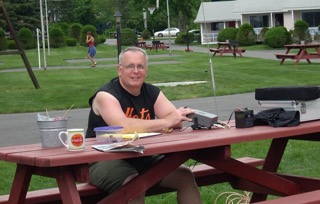 I have always been interested in public service with Amateur Radio. In 1980 I participated in the communications effort during the Olympic Torch Run for the Lake Placid "Miracle on Ice" Olympics. I have served as Net Control for local traffic nets; and have held appointments as an Official Relay Station and as an Official Bulletin Station. During the 1980's I participated in the RACES program and served as a Communications Officer in the Department of Emergency Management for Middlesex County, NJ. Currently, I participate as a RACES and ARES member on the CERT team (Community Emergency Response Team) that our town has organized. Besides my affiliation with the various QRP organizations, I am a Past-President, past Vice-President and current member in the Piscataway Amateur Radio Club. I am also a member of the Electronic Testing Society of New Jersey; or, as it is better known, the ETS of NJ. This fine group of folks maintains the 146.940/.340 Greenbrook repeater which has a statewide reputation. I also served as Vice-President of the Raritan Bay Radio Amateurs who operate out of Sayreville, NJ. I was a Volunteer Examiner with that group; and eventually took it over, becoming the VE Liaison. Because of my efforts in running Sayreville's VE program, I was awarded, in 1998, the "Elmer of the Year" award by QCWA Marconi Chapter 138. To date, this is my proudest achievement in Amateur Radio. I still VE with a group of hams affiliated with both the ETS of NJ, and the South Plainfield Amateur Radio Club - a new club that we formed in town in April 2014. My main interests are Morse Code, homebrewing and QRP. However, I also like to chase DX, ragchew, work Special Event stations and earn their certificates. I have earned WAS, WAC, DXCC and DXCC Millennium, all using wire antennas. My rigs are two Elecraft KX3s. One is kept as the "shack radio" in the basement and one is kept in a backpack, always ready to go in a moment's notice for portable QRP ops. In fact, it goes to work with me everyday, and I spend most of my lunch hours in the car, working some DX or having a rag chew. "Amateur Radio and the Great Outdoors - Perfect Together" is a motto that I try to live by. I'm also an ARRL Certified Instructor, and participate in teaching licensing classes whenever I can. It's a good way to give back for all the enjoyment that Amateur Radio has given me over the years. 73 de Larry W2LJ QRP - When you care to send the very least!
Dave Raycroft, VA3RJ/VE3JDR, #0004
My name is Dave, and I was born in Hamilton, Ontario, Canada, on July 7, 1948.NAQCC Membership Database Keeper 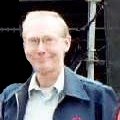
In High School, I majored in mechanical drafting and machine shop. I finished off my education at Mohawk College (Hamilton, Ontario) with an electronics technician course. My work career has included a wide range of varied and interesting jobs. These included cable television, broadcast television (CKNY-TV, North Bay, Ontario), audio/visual and TV production at McMaster University (Hamilton, Ontario), chief engineer for the Media Prduction Department of Seneca College, Toronto (television production), and finally into the video security and surveilance field. I was first introduced to amateur radio while attending the Sportsman's Show in Toronto, in 1964. I was amazed when I heard a gentleman talking to someone in Bermuda via two-way radio. Jean Evans, VE3DGG (SK), who was taking part in the amateur radio demonstration, came over to me and explained what ham radio was all about. Jean made arrangements for me to visit a ham operator back in Hamilton (Tom Stewart, VE3IM) who explained the hobby in more detail, and gave me a tour of his station. I was on my way - bitten by the bug. My first step was getting involved in shortwave listening with a very simple multi-band, transistor, receiver. On February 10, 1965, I received my Canadian SWL callsign VE3PE2FE, which I still hold to this day. The small transistor radio was soon replaced with a second-hand Hallicrafters general coverage shortwave receiver, with bfo, which would eventually become my first ham radio receiver. For the next two years I studied on my own, in my spare time, with books from the library as well as the ham's Bible (ARRL Amateur Radio Handbook). I memorized the Morse code, listened to code on my tape recorder, and later copied transmissions from ARRL headquarters, W1AW, for code practice. By no means did Morse code come to me over night. It took quite a while, and a lot of patience. But once I got it, I had it. Now it was just a matter of increasing my speed to 10 words per minute for the Canadian Amateur Operators License. This being your first license, at that time, in Canada. On February 17, 1967, I made the big step and took the examination for my Amateur Certificate of Proficiency in Radio, through the Department of Communications. To my delight, I passed and was issued the callsign VE3BMR, and I was on the air March 16, 1967. January 2, 1968, my license was upgraded to include voice operation on the 10 meter band. As my love for Morse code (CW) continued, I did little in the way of voice operation. After a lot of prodding by my ham friends, I upgraded my license to Advanced Amateur Operator (Canada's highest license class) on July 14, 1972. This license gave me full privileges, CW, SSB, etc. Even with full privileges, I still operated 95% CW, and still do to this very day. CW is my favorite mode of operation and always will be. The year 1993 saw another major change. Ontario introduced the VA3 callsign prefix. This gave me a chance to obtain a two letter suffix callsign (available to hams who have been licensed for ten years or more). I was issued the callsign VA3RJ. I held on to both callsigns (VE3BMR and VA3RJ) for two years, and eventually relinquished VE3BMR March 3, 1995. My old callsign ended up in good hands, being used by the Blue Mountain Radio Club in Collingwood, Ontario. I enjoy working contests, DX, county hunting, island hunting, and general rag chewing. I also homebrew my equipment as much as possible. My station could be considered a museum. I run the old Heathkit twins, SB-301 receiver and SB401 transmitter, which I maintain on a regular basis. and they still perform quite well. Two meter FM is also Heathkit (HW-2036A). Also on HF is a Yaesu FT-890, FC-902 antenna tuner. For VHF/UHF receive, a Yaesu FRG9600 all mode receiver is used along with Radio Shack HTX-202 and HTX-404 mono-band handheld FM transceivers. An Elecraft K1 4 band xcvr is used exclusively for QRP CW and a Softrock SDR (Ensemble RXTX Transceiver) is used for WSPR mode. The remainder of the station is homebrew. I am a member of Radio Amateurs of Canada (RAC), Contest Club Ontario - CCO, 10-X #05247, ARS #1401, BARLS #106, CTC #089, DL-QRP-AG #2341, DMC #1604, EPC #011, FISTS #6196, FPqrp #508, GACW #658, GTC #130, I-QRP #463, NAQCC #0004, NJ-QRP #408, MARAC #R-0960, SKCC #2292, SOC #539, SRT #375, SV-CW-C #130, OTC, RCC, and hold DXCC, WAC, WAS, WAZ, USA-CA awards, to name a few. I also now hold a second call sign, VE3JDR, which are my initials (John David Raycroft). My other leisure activities include walking, mountain biking, Tai Chi, photography, fishing (when I get the chance), and some coin/stamp collecting.
Brion Jorgensen, VE3FUJ, #3011
CW Assistance Program Manager  Hi All, I'm VE3FUJ Brion NAQCC #3011. I learned Morse code as a Cub-Scout (to earn a merit badge) in the Dark days of the early 40's, in my native Country of Denmark. One of the other Cubs lived in the same apartment complex. We made up code senders using batteries and light-bulbs. We mounted the bulbs in a small cardboard tube so the light would not be picked up by snooping eyes (German). It had to be pointed directly at whoever you wanted to receive it. That way we could practice code and send each other messages.
Hi All, I'm VE3FUJ Brion NAQCC #3011. I learned Morse code as a Cub-Scout (to earn a merit badge) in the Dark days of the early 40's, in my native Country of Denmark. One of the other Cubs lived in the same apartment complex. We made up code senders using batteries and light-bulbs. We mounted the bulbs in a small cardboard tube so the light would not be picked up by snooping eyes (German). It had to be pointed directly at whoever you wanted to receive it. That way we could practice code and send each other messages.In 1955 I had a job as a Ships-carpenter in another town, while there, I lived in a Boarding house, where I was befriended by a Radio Technician who came there for his meals, he invited me to come to the shop where he had a room in the back. He also happened to be a Ham operating out of his room with all home brew equipment. I seem to recall him saying it was 350W A.M. TX and a double conversion RX. Another of the thing I remember was a fluorescent tube leaning against the window frame next to the antenna coupler, and every time he hit the send button it would light up. I also remember him telling me the antenna was a 600 ohm folded dipole, with open wire feed, the length about 20 mtrs which would then be the 40 m band. ----- That's when I realized I had gotten hooked on Ham Radio. In May 1956 I left Denmark to come to Canada, it took 8+ years before I had settled enough to take up on getting a ham License. I started attending evening classes i Hamilton Ont. for the theory and a brush up on the code. In the spring of 64 I received my Ticket "Basic Amateur" and the call VE3FUJ. I was relegated to the CW portion of the HF bands. After six month I got an endorsement for Phone on 10 mtr and proceeded with SSB on that band, simply could not be bothered with CW anymore. Then in 1965 - 66 I attended evening classes again to get the "Advanced Amateur" ticket which I passed in May 66. In early to mid 70's I bored with SSB and had gotten too busy with Family matters that I drifted away from Radio, sold my Rig and forgot all about it. I did keep my Johnson Speed-x straight key. In 2005 we pulled up stakes and moved up country to a small rural town, and in 2006 I opened a yet unopened box, found the old key and yes, thoughts went to Ham radio again. In the preceding years I had enough foresight to keep up my License Fees. In 2000 I received a letter from Industry Canada ( the then governing body ) that I no longer needed to pay a yearly fee again, that coincided with my decision to stop paying the license fee. Perfect timing. Forward to 2006 again. I decided to get one of the small 1.1/2 W rock bound Tx's, I already had a shortwave Rx with BFO. It went from there. Before I realized it I was hooked on QRP, after a few upgrades I'm still at it. Meanwhile I had joined a few of the "join for free" clubs on the Air. One of course was NAQCC, after a while abt 9Mths I decided to try my hand at the NAQCC contest and challenge, haven't looked back yet. The Pix dates from abt 2009 and the Ten Tec has been gathering dust ever since except for one week-end in March 2010 where I operated as a special Station in the SKCC WES. That bring us to the present. So no more to tell. VE3FUJ Brion # 3011 PS: I have since forgotten the Ham's call sign. I had it written in, I believe 1956 version of the ARRL Hand book ( Black cover ), which I also lost. If some one should happen to have that book with an OZxxxx call written on one of the first pages I would appreciate being informed of that call. (high hopes)
Gary Meyn, K1YAN, #2365
Monthly Challenges Creator 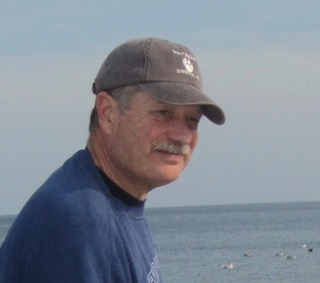 My ham career began in 1962. Three other eight graders and I were motivated, by one guys SWL father, to study and get a novice ticket. After a few months of studying the ARRL license manual and wearing the grooves off an AMECO code record, KN1YAN hit the airwaves. Armed with an Eico 723 transmitter and a Heathkit GR-91 receiver, which was broad as a barn door and deaf as a rock much above 40 meters, I spent the first week or so working the other three guys on 40 meters. We were all scared to call or answer a CQ at first, but that wore off pretty quickly. After a few days I learned about RFI when the hall light started to flash in step with my cw. My second floor shack had no earth ground and the two wire AC system provided no help. Lesson learned.
My ham career began in 1962. Three other eight graders and I were motivated, by one guys SWL father, to study and get a novice ticket. After a few months of studying the ARRL license manual and wearing the grooves off an AMECO code record, KN1YAN hit the airwaves. Armed with an Eico 723 transmitter and a Heathkit GR-91 receiver, which was broad as a barn door and deaf as a rock much above 40 meters, I spent the first week or so working the other three guys on 40 meters. We were all scared to call or answer a CQ at first, but that wore off pretty quickly. After a few days I learned about RFI when the hall light started to flash in step with my cw. My second floor shack had no earth ground and the two wire AC system provided no help. Lesson learned.Upgrading to a Technician license got me into 6 and 2 meter AM and CW. Living in southern Connecticut meant that channel 2 was network TV from NYC and we were in the fringe area. Poor front ends on TV sets, rusty antennas and not so clean 6 meter transmitters led to the WAN ( worked all neighbors ) award, which most of us qualified for pretty quickly. Two meters rapidly became the bread and butter band for me. An upgrade to General class got me back into the HF game again. Back in the day surplus and home-brew gear was the way to go on a high school students budget. The ubiquitous ARC-5 gear provided me with 80 and 40 meter stations and an 8 mHz unit was pressed into service as a VFO for my 2 meter rig. Fortunately, most of my VHF work was on AM, where wandering around the band after multiplying up to 2 meters was not a big issue. The QRP bug got to me pretty early in life and I built a little 80 meter transmitter from junk parts. My father knew a guy in town who repaired radios and TV sets for a living. The sets that were beyond repair landed in our basement, so I had plenty to work with. It was a single 6V6 in a cigar box with a built in power supply, BC radio variable capacitor and a coil wound on a toilet paper cardboard roll using bell wire. Its massive 5 watts were able to net me 14 states in about a year. Operations slowed down in the early 70s due to no antenna policy, apartment living. An attempt at QRP with an "invisible" # 28 wire antenna strung from an apartment window netted a few QSOs and a promise that I would be tossed out if the landlord caught me hamming again. Since then ham activity has been spread between VHF ssb and digital and of course cw. For the past four or five years all my cw has been at QRP or QRPp power. Most operation is rag chewing with a touch of DX and contesting as the mood hits.
Andy Siegel, N2CN, #6028
NAQCC Sprint Scorer 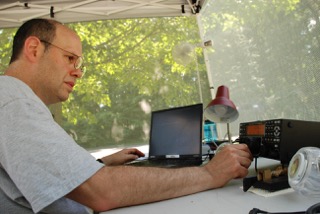 A combination of a self-organized ham club at summer camp, plus a licensing course organized by my music teacher and elmer, Dave Mann, K2AGZ (SK), got me my novice license during high school in 1975. One advantage of living at the time in an apartment building in Manhattan was having a 15-story platform on which to mount an antenna, which in those days was a 5-band, 80-10 meter trap inverted-vee with a nearly 360-degree view of the horizon. And while the famous "Radio Row" on Cortlandt Street had already disappeared by the time I had become a ham, there were still many great stores in New York City such as Harrison Radio, Harvey Radio, Heathkit, Barry Radio, Arrow Electronics, Canal Street, etc. It was a great place and time to be a new ham. I started out with the Heathkit DX-60/HR-10, then the SB-303/401 twins, and later a Kenwood TS-520S.
A combination of a self-organized ham club at summer camp, plus a licensing course organized by my music teacher and elmer, Dave Mann, K2AGZ (SK), got me my novice license during high school in 1975. One advantage of living at the time in an apartment building in Manhattan was having a 15-story platform on which to mount an antenna, which in those days was a 5-band, 80-10 meter trap inverted-vee with a nearly 360-degree view of the horizon. And while the famous "Radio Row" on Cortlandt Street had already disappeared by the time I had become a ham, there were still many great stores in New York City such as Harrison Radio, Harvey Radio, Heathkit, Barry Radio, Arrow Electronics, Canal Street, etc. It was a great place and time to be a new ham. I started out with the Heathkit DX-60/HR-10, then the SB-303/401 twins, and later a Kenwood TS-520S.I was active throughout college, but afterward ham radio took a back seat to career and family. It wasn't until my kids had reached middle school that the bug bit me again, and I returned to the air in 2005, first with a Kenwood TS-120, then a Yaesu FT-450AT, and now with an Elecraft K3. I also have a Wilderness Radio NorCal 40A for portable QRP work. My station philosophies are "keep it simple" and "keep the XYL happy", which means wire antennas and a compact station. The only thing I would say I have a weakness for are paddles: a Brown Brothers BTL-A from my teenage years, a Bencher BY-1, an American Morse Bushwhacker, and a Begali HST-2 that is my daily driver. For a straight key, I use a J-38. My antennas as of January 2015 are a ZS6BKW multiband dipole up about 60 feet, and a 30m dipole at 40 feet. I'm fortunate to have high antennas and a low-noise QTH, so I have little trouble hearing and being heard. I enjoy casual operation, almost entirely CW on the HF bands. I also enjoy the NAQCC sprints, and I love Field Day. I am a member of the Stamford (Connecticut) Amateur Radio Association, and we run a very competitive Field Day operation with the call W1EE in class 3A. I've made an enjoyable and interesting career out of Unix/Linux software development and systems administration. In addition to ham radio and computers, I enjoy history, industrial archaeology, early music, hiking, and genealogy.
Paul Neuman, KD2MX, #1091
That old National SW-54 in the photo is the twin of the receiver that kept me up late nights as a kid and served as my intro to ham radio. I saw this one on Ebay and had to get it. NAQCC Recruitment / Member News Editor / Member Spotlight 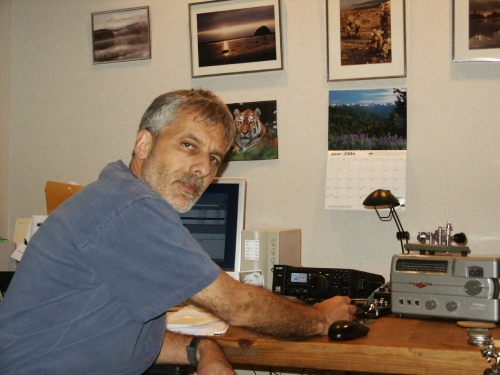
I received my Technician license in 1968 when I was in eighth grade and was assigned WB2HEO. I really enjoyed 2 meters back in those days and had lots of fun with my old Clegg 22er. I upgraded to General and then to Advanced over the next couple of years and worked mostly all SSB on HF. I never took to CW back then. I enjoyed building Heathkits, although I made quite a mess of the first kit or two, and needed some patient Elmers to help straighten things out. I got pretty good at it and built stereos and weather equipment along with ham kits. It was a sad day when Heathkit closed down. I was a music major in college (percussion) until I figured out that I wasn't talented enough to do much more than be a teacher, which I wasn't very interested in being, so I switched to Communications. After college, I worked for a few years as a Copywriter at Prentice-Hall and then at a local newspaper. I also lost interest in ham radio during my college years and sold off my equipment and took down my antennas. In the early '80s, I got into computer programming and worked as a COBOL programmer, mainly on DEC PDP and VAX computers. Trying to stuff a COBOL program into the PDP's limited address space was an interesting exercise, and the implementation of virtual address space on the VAX was a wonderful thing. This was back in the days when 1MB of memory was a really big deal. Somewhere along the way I traded in my call for a 2x2 and was assigned KD2MX, not a bad CW call, but with work, a house, and two kids, I had neither the time nor resources for ham radio. I then worked for Digital Equipment Corp. at the peak of their glory years. It was all downhill for the company but I spent some good years there delivering performance and capacity planning services before the bottom dropped out. I then joined a small startup computer system integration company. I was a partner there for nearly 20 years before retiring a few years ago. I took the plunge back into ham radio in 2005, after an absence of more than 20 years. RFI problems caused me to try QRP and I then got into CW since QRP SSB is a bit of a challenge. I stumbled upon the November '05 NAQCC Sprint and worked K3WWP for my first QRP contact. I've had a ton of fun since and have been just amazed at what you can do with just 5 watts. I solved the RFI problem long ago (mostly) but continue to run QRP much of the time. I've since logged tens of thousands of QSOs, done a lot of contesting, and have built countless kits (most of which actually work). My trusty FT-897 is still my go-to rig. I also use a Genesis G11 SDR transceiver which is sure a long way from the National SW-54. There are so many facets of ham radio and I am constantly trying something new (like SDR). I've done a lot with the digital modes over the past year or two. The coolest thing was rigging my Raspberry Pi up as a WSPR transmitter and receiving reports from VK-land, an awful lot of miles per milliwatt. Besides ham radio, I love to hike and usually get out once or twice a week. Despite living in densely populated North Jersey, I am fortunate to have many miles of excellent trails within 15 minutes of home, and countless miles within an hour or two of here. I still play percussion for a local community orchestra. And I read a lot of non-fiction. I cover all topics but am especially interested in environmental and transportation issues, politics, science, and history. I also walk and train dogs at the local animal shelter as our two cats made it very clear that they did not want a dog in "their" house. I tend to work with the dogs that have 'issues', those that need some special attention and a good friend to help them deal with the stress of shelter life until they find a new home. 73/72 to all and I look forward to many wonderful QRP QSOs in the years to come. Lyle Crane, AF7OS, #7859
Picture Gallery Manager 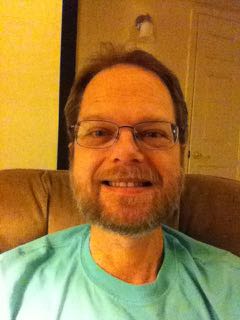 I got my first ham license (KB7EZO) while attending George Fox College working toward my BA in Music Education in the 80's with a Novice license. Back then, you only had to know 5 WPM. After graduating, my wife and I moved to the Oregon coast in Waldport and I set up a 10 meter rig and a Radio Shack 2 meter HT. My wife got her license there, KC7HRP, and I upgraded my license to a Tech-plus. We both became active in ARES and participated in several Tsunami drills and well as getting our advanced first aid certifications.
I got my first ham license (KB7EZO) while attending George Fox College working toward my BA in Music Education in the 80's with a Novice license. Back then, you only had to know 5 WPM. After graduating, my wife and I moved to the Oregon coast in Waldport and I set up a 10 meter rig and a Radio Shack 2 meter HT. My wife got her license there, KC7HRP, and I upgraded my license to a Tech-plus. We both became active in ARES and participated in several Tsunami drills and well as getting our advanced first aid certifications.In the mid 90's, education budgets were hit hard in Oregon and I moved my family to Lyons, Kansas to continue teaching. While there, we again participated in ARES activities but soon again the budget crunch hit again and we moved to a little town in southwest Kansas called Mullinville. Not a lot there and the cows outnumbered the people. Having only a 10 meter radio and a 2 meter HT, contacts became few and far between. And, with gearing up with computers and getting additional certifications in web development and system administrations, I let my license expire and quietly went off the air. In 2003, I stopped teaching and pursued my computer career in Arizona and moved to the Phoenix area where my father-in-law, KE7MVJ, reintroduced me to ham radio. My radio gear that I had in Kansas was destroyed in the tornado that took out Greensburg so I had to start over. I looked on the internet and found the Superstition Amateur Radio Club near my home and, in July 2014, took the test to see where I was. I ended up passing the General first time. Guess I didn't forget as much as I had thought! This time my call was KG7NHR. I picked up a cheap Chinese radio and got on the local nets again and soon my father-in-law introduced me to HF. I started messing with the bands with what I could with my General but found it too restricting. So, I got online and studied for my Extra and passed in February 2015 opening up a whole new world for me with my current call AF7OS. Then I began to wonder, how much CW do I remember? Saved up my pennies and got a Yaesu FT-815ND and started listening and discovered I was able to pick out a letter here and there. One of the club members gave me a much loved straight key from a SK and I fixed the wiring and decided to get back into CW. Seeing my interest in CW, one the the elmers of the club, NB7C, suggested I join NAQCC and SKCC to have someone to "talk" to. I'm now enjoying hiking with my wife and radio making contacts while sitting on top of many of the mountains Phoenix has to offer. Tom Mitchell, WY3H (ex-KB3LFC), #0001
It was in the late 1980s and early 1990s that I developed a love for QRP operation and CW while living in Schuylkill County, Pa. I operated almost strictly QRP CW (although I did operate some QRP SSB using a Ten Tec Argonaut 509), until a house fire in 1993 destroyed all my amateur radio equipment with the sole exception of an HW-7.NAQCC Founding President (Retired) 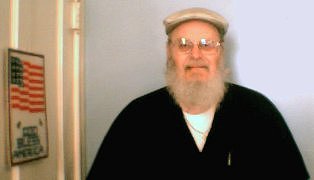 From 1993 to 2004, I went into a hiatus as far as radio activities were concerned. My Advanced-class license, KC3YD, expired in 2000 and I didn't bother to renew it. However, in 2004, I again got "the bug" for radio and in May obtained a Technician-class ticket with my new call, KB3LFC. In June I passed the General-class exam and retained the same call. 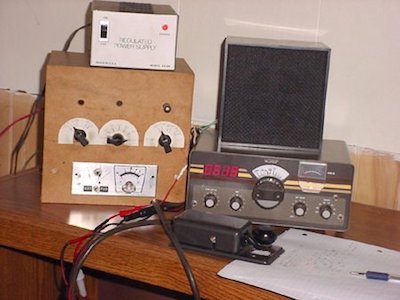 At that time, thanks to the donation of a wonderful HW-9, I got back on the air, (also with the temporary loan of a homebrew tuner). Thanks to help from my devoted XYL, JoAnne, a 225-foot random wire antenna was strung up and soon the sounds of CW penetrated the air waves. I'm presently 60 years old (2004) and due to some bad knees and a bad hip, cannot do a lot of climbing, and that's where JoAnne's willing and selfless help became invaluable.
At that time, thanks to the donation of a wonderful HW-9, I got back on the air, (also with the temporary loan of a homebrew tuner). Thanks to help from my devoted XYL, JoAnne, a 225-foot random wire antenna was strung up and soon the sounds of CW penetrated the air waves. I'm presently 60 years old (2004) and due to some bad knees and a bad hip, cannot do a lot of climbing, and that's where JoAnne's willing and selfless help became invaluable.My station consists of a modified HW-9, homebrew tuner and surplus Russian straight key. Antenna is a random wire approximately 225 feet in length. The beauty of QRP stations lies in their simplicity and low cost. Let me say that I am not by any means a top notch CW operator. The fact is, compared to most CW ops, I am painfully slow. However, that does not keep me from enjoying one of the hobbies I enjoy the most. While on the air I never met a CW op who didn't extend the courtesy of heeding my request to PSE QRS. In September, 2004, with the help and encouragement of my friend (and mentor) John Shannon, K3WWP, I decided to form the North American QRP CW Club. The club's aim and purpose is to promote QRP and CW operation - and simply experience the thrill of such operation. John Shannon, K3WWP, #0002
NAQCC Founding Vice-President (Retired) / Western PA Chapter 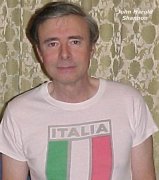 I was born in 1945 and was first licensed as KN3WWP in April of 1963. I upgraded to General in the fall of 1963, and to Extra when incentive licensing came along in 1968.
I was born in 1945 and was first licensed as KN3WWP in April of 1963. I upgraded to General in the fall of 1963, and to Extra when incentive licensing came along in 1968.From 1963 to 1973 I spent most of my hamming in county hunting, contesting, and rag chewing. In 1966 I co-founded the CW County Hunters Net with Dave WA8EOH. I started work at WPIT in Pittsburgh in 1969, and continued working there until 1993. That cut down on my hamming, keeping me off the air entirely for several years. I was able to get in some hamming from 1981 to 1983. I continued my county hunting, rag chewing, and contesting. It was then the 30 meter band first became available to amateurs. It quickly became one of my favorites and remains so today. 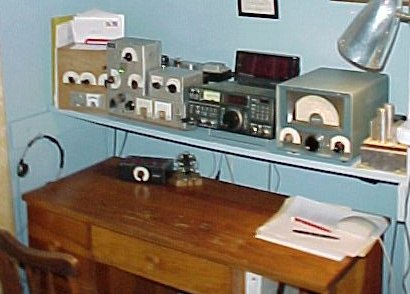 In the early part of 1993, WPIT was sold, all the employees were released and I decided to retire to help take care of my aging mother. About that time, my friend Eric, my next-door neighbor at the time (who is now KB3BFQ) wanted to know all about ham radio, and we put my station back together and I got on the air again. The station shortly after that is pictured at the right. L-R on the shelf are my homebrew antenna tuner with built in homebrew power/SWR meter, homebrew xmtr with a 6Y6 final amp, IC-71A receiver, much modified old Lafayette VFO, and VFO power supply. On the desk are my homebrew keyer and paddle. In 1999 I bought a Kenwood TS-570D to make operating contests and DX easier, since with my homebrew setup I had to change as many as 12 or more controls to switch bands.
In the early part of 1993, WPIT was sold, all the employees were released and I decided to retire to help take care of my aging mother. About that time, my friend Eric, my next-door neighbor at the time (who is now KB3BFQ) wanted to know all about ham radio, and we put my station back together and I got on the air again. The station shortly after that is pictured at the right. L-R on the shelf are my homebrew antenna tuner with built in homebrew power/SWR meter, homebrew xmtr with a 6Y6 final amp, IC-71A receiver, much modified old Lafayette VFO, and VFO power supply. On the desk are my homebrew keyer and paddle. In 1999 I bought a Kenwood TS-570D to make operating contests and DX easier, since with my homebrew setup I had to change as many as 12 or more controls to switch bands.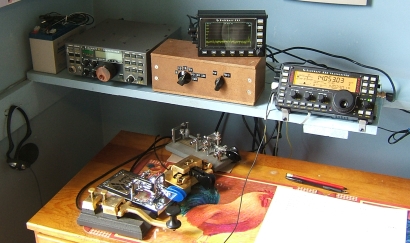 My station evolved over the years with different rigs, keys, and other equipment. In addition to the items pictured at left in a photo from October 2014, I've also used a TS-480SAT, Elecraft KX-1 and various homebrew keys and paddles including a Bencher paddle given to me by Mike KC2EGL. Now at left you see on the shelf L-R, my 7Ah gel cell for portable or emergency operation, my Elecraft K2, antenna switch with my Elecraft PX3 panadapter on top, and my Elecraft KX3. On the desk covered by the chicken place mat to provide a smooth writing surface after the desktop suffered nicks, etc. over the years as a workbench you see my current key collection. The keys are F-B or L-R, a Begali Blade straight key, an ARRL Centennial Paddle, a Begali magnetic classic paddle, and a Vibroplex Lightning Bug. The first three were gifts from you members via your donations. The bug was a gift from Larry W2LJ. All four are wired into the KX3 and I can switch seamlessly among them at will. Also there is my paper log which later gets transferred to computer. Thanks to all of you for the gifts.
My station evolved over the years with different rigs, keys, and other equipment. In addition to the items pictured at left in a photo from October 2014, I've also used a TS-480SAT, Elecraft KX-1 and various homebrew keys and paddles including a Bencher paddle given to me by Mike KC2EGL. Now at left you see on the shelf L-R, my 7Ah gel cell for portable or emergency operation, my Elecraft K2, antenna switch with my Elecraft PX3 panadapter on top, and my Elecraft KX3. On the desk covered by the chicken place mat to provide a smooth writing surface after the desktop suffered nicks, etc. over the years as a workbench you see my current key collection. The keys are F-B or L-R, a Begali Blade straight key, an ARRL Centennial Paddle, a Begali magnetic classic paddle, and a Vibroplex Lightning Bug. The first three were gifts from you members via your donations. The bug was a gift from Larry W2LJ. All four are wired into the KX3 and I can switch seamlessly among them at will. Also there is my paper log which later gets transferred to computer. Thanks to all of you for the gifts.I have been very active since 1993 with the various setups. I've made at least one QRP QSO each day starting August 5, 1994 when Eric suggested I see how many consecutive days I could make a QSO using QRP / CW / simple wire antennas. The "streak" is now close to 24 years and still going strong at 8,754 days. It will continue until something beyond my control brings it to an end. I have a concurrent DX (non-W/VE) streak which started March 1, 2013 and is now approaching 2,000 days and also going strong at 1,971 days. My total number of QSOs (all CW with QRP and simple wire antennas) since returning to the air in 1993 is 71,250 of which 23,675 are DX QSOs. Included are QSOs from 225 DX entities, all 50 states, all continents (including Antarctica), and 36 of 40 CQ zones. Along with my pre-1993 contacts, that's 90,621 QSO's since April 3, 1963 (all CW except for 3 SSB and 2 AM QSO's in 1969 testing other hams' rigs for them.) If I add 4,650 QSOs made with other calls and/or at other locations such as K3WWP/3, WA3IXO, KB3MQT, N3AQC, N3A, K3MJW, and NY3EC, that makes 95,721 contacts. I hope I can make it to 100,000. Stats in this paragraph are current as of July 23, 2018. As I jump around in time in this story, let's now go to 2004. I was delighted when Tom KB3LFC (now WY3H) wanted to write an article about my ham radio activities in the local paper. I had no idea then he was also a ham. We became good friends and I was delighted to get involved when he wanted to start a QRP club which of course is our NAQCC since it promotes the three things I like about ham radio - CW, QRP, and simple wire antennas. I have also been a member of the marvelous FISTS club since the mid-1990s. My number is 2002. I've earned many of their awards. I wrote the QRP column for their publication "Keynote" for some 20 years producing 100 columns before retiring about the same time I retired as NAQCC VP. Everyone who is a NAQCC member should also be a FISTS member. I've got my own web site with much info on CW and QRP at http://k3wwp.com. I invite you to visit me there sometime. I want to thank you all for the great times you gave me in the ten years I served as NAQCC VP before partially retiring in 2014. Also for the time I continued after that as sprint log cross-checker until I retired from that at the end of 2017. I admire you all for your devotion to QRP and CW which has helped prove over the years just how wonderful a mode CW is, and how efficient it is, even at QRP power levels. I'm glad you are continuing your devotion under our new club management. I'm still continuing with one role in the club taking care of our WPA Chapter activities as sort of a chapter leader and coordinator. Jeff Hanscom, KA1DBE, #1570
Downeast Maine Chapter 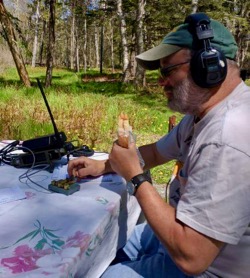 My name is Jeff, KA1DBE. I was first licensed in 1979 at the age of 14. I enjoy all aspects of Ham radio and especially like QRP, CW, SOTA and contesting. I moved back to Maine from Virginia in 2016. I am a member of the Ellsworth Amateur Wireless Association, Virginia Beach Amateur Radio Club, NAQCC, QRPARCI, NEQRP, and SKCC.
My name is Jeff, KA1DBE. I was first licensed in 1979 at the age of 14. I enjoy all aspects of Ham radio and especially like QRP, CW, SOTA and contesting. I moved back to Maine from Virginia in 2016. I am a member of the Ellsworth Amateur Wireless Association, Virginia Beach Amateur Radio Club, NAQCC, QRPARCI, NEQRP, and SKCC.Danny Goodrum, N5DRG, #5861
Central Texas Chapter 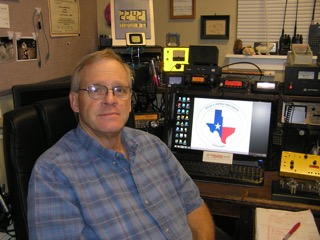 My history with radio began in 1967 at the age of 9, I had a chance to build a Crystal Radio kit with my dad. It was part of the Boy Scouts (Cub Scouts) project. I can still remember Dad and I finding ourselves looking at parts of a Crystal Controlled Radio and saying 'what no batteries' and 'this will never work'. I felt a sense of bewilderment the first time we found the sweet spot on the Galena Crystal and heard an AM broadcast. It was magic.
My history with radio began in 1967 at the age of 9, I had a chance to build a Crystal Radio kit with my dad. It was part of the Boy Scouts (Cub Scouts) project. I can still remember Dad and I finding ourselves looking at parts of a Crystal Controlled Radio and saying 'what no batteries' and 'this will never work'. I felt a sense of bewilderment the first time we found the sweet spot on the Galena Crystal and heard an AM broadcast. It was magic.Then in the mid 1970's, I was hooked again. There was a group of radio enthusiasts in the North Austin area very dedicated to their hobby, to that end, most of that group migrated into Ham Radio. I obtained first license in January of 2000, KD5JFJ, and within three months upgraded to General, changing my call to N5DRG. I have enjoyed building antennas over the years, and have built a few Yagi's, Quagi's, Loops and a Hex Beam from scratch using the K4KIO specifications, and some for VHF/UHF. I have also built a three element Mono-band Yagi for 17 Meters and had it published on HamUniverse.com. Since then several Hams from the USA, Europe, and South America have built one like it, and have stated how well it has worked for them. My current QRP station consists of a Hendricks PFR-3, American Morse Express Porta-Paddle II, Emtech Z Match Tuner, plus a couple of End Fed antennas for various bands. I am member of the Central Texas Ham-Buds Amateur Radio Club in Cedar Park, Leander, and North Austin area, also a member of the N.A.Q.C.C. Central Texas Chapter. I have participated in the Summits On The Air Activations when time permits, and do chase the ones doing the summit activation. In February 2014, a few Hams in our local radio club participated in S.O.T.A. activation of Designator W5T/CI-OO1 Emory Peak (second highest peak in Texas-7832 ft. ASL). I hope to make a few more activation's in the future. JB Still, NR5NN, #5604
NCS for the Farnsword Nets 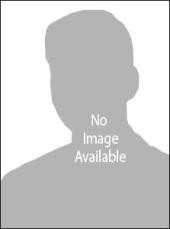 JB Still, KR5RR. My ideal "vanity" call sign would be TI5YO - Terribly Inquisitive 5 Year Old. Fascination with radios and electronics probably started when SWL'ing with my Dad. Boy Scout Radio Merit Badge, then Novice at 12 or 13, General, 2nd Class Radio Telegraph, and 1st Class Radio Telephone licenses followed.
JB Still, KR5RR. My ideal "vanity" call sign would be TI5YO - Terribly Inquisitive 5 Year Old. Fascination with radios and electronics probably started when SWL'ing with my Dad. Boy Scout Radio Merit Badge, then Novice at 12 or 13, General, 2nd Class Radio Telegraph, and 1st Class Radio Telephone licenses followed. Worked the last two years of college as a part time Associate Field Engineer for IBM. After graduation, landed my dream job as a Field Engineer for Collins Radio, primarily on computer controlled radio systems and avionics, traveling throughout the USA, and some parts of the world. While on assignment in Southern California, I met a girl. Kinda burned out on computer controlled radios, went QRT for family, career and stuff. Transitioned over 40 years through mainframe and minicomputer systems and peripherals, computer graphics systems, X-Rays & CAT scanners, to PC controlled clinical diagnostic instruments and systems. Ocean kayaking and VHF marine radio rekindled my interest in ham radio, where I discovered really inexpensive PC controlled Software Defined Radios (SoftRock RXTX kits). Worked 37 states and 17 countries QRPp (6,000+ miles with 1 watt many times to Eastern Europe and Asia Pacific on 30m & 17m) before I burned out on SDRs, mainly the computer software part. Now enjoy building kits, wire antennas of all shapes and sizes, and CW ops with simple traditional transceivers (no computers!). That girl and I are still in California. However, I occasionally have to remind her that the inquisitiveness, wonder and excitement of what all that wire in the air over our house can do, is what started this marvelous career, life and adventure we've shared and enjoyed. 73 de JB.kr5rr Allen Matthews, KA5TJS, #4512
NCS for the East Texas QRS Net  Hello, I am Allen KA5TJS in San Augustine, TX. That is about 40 miles east of Lufkin and in what we call the Piney Woods of East Texas. We moved here about 9 years ago from Houston and that was when I got back on the air. I had an old Kenwood 440AT and thought I would get back into ham radio. I put up an antenna and here we are.
Hello, I am Allen KA5TJS in San Augustine, TX. That is about 40 miles east of Lufkin and in what we call the Piney Woods of East Texas. We moved here about 9 years ago from Houston and that was when I got back on the air. I had an old Kenwood 440AT and thought I would get back into ham radio. I put up an antenna and here we are.The current station is an ICOM 7410, ICOM 746PRO and a Yaesu FT-817. I can and do work QRP on all three. I also have built a Small Wonders SW40 and an Oak Hills Research 100A both for 40 meters. The antenna is an 80 meter dipole at about 30 ft. and fed with window line thru my MFJ949E tuner thru the 4:1 balun. It works well on 80 thru 10 except for 17 meters. I joined the NAQCC and tried to check into the various QRS nets and did not have much luck. We did not have a QRP net in the south central area. I offered to start one and that was in January of 2011. We are still here and having fun. We don't have a lot of check ins but a great group. I have met some great new friends on the net. I enjoy working the NAQCC Sprints and I am an active member of the SKCC and the ARRL. I check into the Ratchet Jaw Club on 3.93450 every morning and host that group on Thursday and that is about the only time I use a mike. My wife and I like fishing, riding motor cycles and gardening. We also keep chickens and ducks. We have 2 dogs in the back yard. |